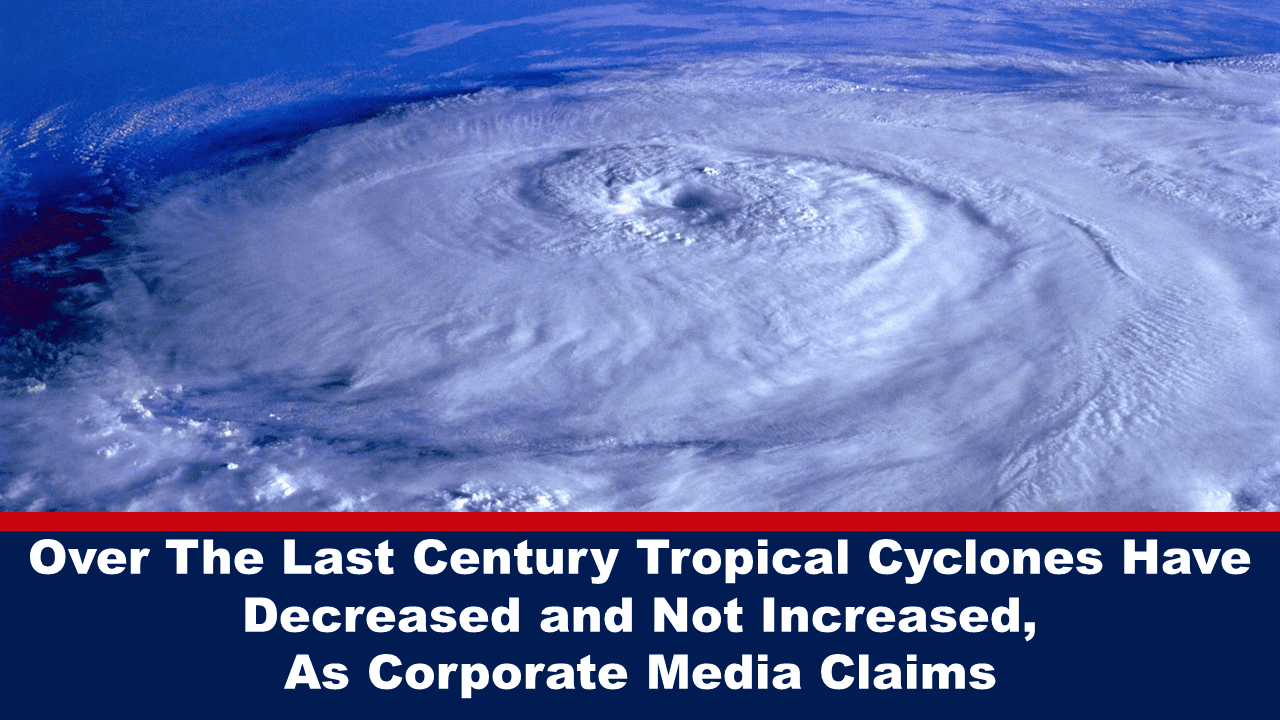
Over The Last Century Tropical Cyclones Have Decreased and Not Increased, As Corporate Media Claims
Dr. Ralph Alexander, a retired American physicist and author, fact-checks corporate media’s climate change narrative.
Corporate media claims climate change is causing more frequent and stronger hurricanes. According to several studies this is untrue. In fact, a 2022 study reveals tropical cyclones in general – which include hurricanes, typhoons and tropical storms – are letting up and have declined by about 13% over the last 112 years, he wrote.

By Dr. Ralph Alexander, republished from CLINTEL
Despite the claims of activists and the corporate media that climate change is making major hurricanes – such as U.S. Hurricane Harvey in 2017 or Hurricane Katrina in 2005 – more frequent and stronger, several recent studies have found no evidence for either of these assertions.
In fact, a 2022 study reveals that tropical cyclones in general, which include hurricanes, typhoons and tropical storms, are letting up as the globe warms. Over the period from 1900 to 2012, the study authors found that the annual number of tropical cyclones declined by about 13% compared with the period between 1850 and 1900, when such powerful storms were actually on the rise.
This is illustrated in the figure below, showing the tropical cyclone trend calculated by the researchers, using a combination of actual sea-level observations and climate model experiments. The solid blue line is the annual number of tropical cyclones globally, and the red line is a five-year running mean.

The tropical cyclone trend is almost the opposite of the temperature trend: the average global temperature went down from 1880 to 1910, and increased by approximately 1.0 degrees Celsius (1.8 degrees Fahrenheit) between 1910 and 2012. After 1950, the rate of cyclone decline accelerated to about 23% compared to the 1850-1900 baseline, as global warming increased during the second half of the 20th century. Although the study authors noted a variation from one ocean basin to another, all basins demonstrated the same downward trend.
The authors remark how their findings are consistent with the predictions of climate models, in spite of the popular belief that a warming climate will spawn more, not fewer, hurricanes and typhoons, as more water evaporates into the atmosphere from the oceans and provides extra fuel. At the same time, however, tropical cyclone formation is inhibited by wind shear, which also increases as sea surface temperatures rise.
Some climate scientists share the view of the IPCC (Intergovernmental Panel on Climate Change)’s Sixth Assessment Report that, while tropical cyclones overall may be diminishing as the climate changes, the strongest storms are becoming more common, especially in the North Atlantic. The next figure depicts the frequency of all major North Atlantic hurricanes back to 1851. Major hurricanes in Categories 3, 4 or 5 have a top wind speed of 178 km per hour (111 mph) or higher.

You can see that hurricane activity in this basin has escalated over the last 20 years, especially in 2005 and 2020. But, despite the upsurge, the data also show that the frequency of major North Atlantic hurricanes in recent decades is merely comparable to that in the 1950s and 1960s – a period when the earth was cooling rather than warming.
A team of hurricane experts concluded in a 2021 study that, at least in the Atlantic, the recent apparent increase in major hurricanes results from improvements in observational capabilities since 1970 and is unlikely to be a true climate trend. And, even though it appears that major Atlantic hurricanes were less frequent before about 1940, the lower numbers simply reflect the relative lack of measurements in early years of the record. Aircraft reconnaissance flights to gather data on hurricanes only began in 1944, while satellite coverage dates only from the 1960s.
The team of experts found that once they corrected the data for undercounts in the pre-satellite era, there were no significant recent increases in the frequency of either major or all North Atlantic hurricanes. They suggested that the reduction in major hurricanes between the 1970s and the 1990s, clearly visible in the figure above, could have been the result of natural climate variability or possibly aerosol-induced weakening.

Natural climate cycles thought to contribute to Atlantic hurricanes include the AMO (Atlantic Multi-Decadal Oscillation) and La Niña, the cool phase of the El Niño – Southern Oscillation (ENSO). The AMO, which has a cycle time of approximately 65 years and alternates between warm and cool phases, governs many extremes, such as cyclonic storms in the Atlantic basin and major floods in eastern North America and western Europe. In the US, La Niñas influence major landfalling hurricanes.
Just as there’s no good evidence that global warming is increasing the strength of hurricanes, the same is true for their typhoon cousins in the north western Pacific. Although long-term data on major typhoons is not available, the frequency of all typhoon categories combined appears to be unchanged since 1951, according to the Japan Meteorological Agency. Yet a new study demonstrates a decline in both total and major typhoons for the 32-year period from 1990 to 2021, reinforcing the recent decrease in global tropical cyclones discussed above.
About the Author
Retired physicist Dr. Ralph B. Alexander is the author of Global Warming False Alarm and Science Under Attack: The Age of Unreason. He blogs at his website Science Under Attack.
With a PhD in physics from the University of Oxford, he is also the author of numerous scientific papers and reports on complex technical issues. His thesis research in the interdisciplinary area of ion-solid interactions reflected his interest in a wide range of scientific topics.
Dr. Alexander has been a researcher at major laboratories in Europe and Australia, a professor at Wayne State University in Detroit, the co-founder of an entrepreneurial materials company, and a market analyst in environmentally friendly materials for a small consulting firm.
Dr. Alexander is a USA signee of the CLINTEL World Climate Declaration.









